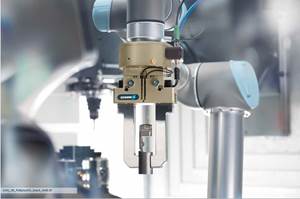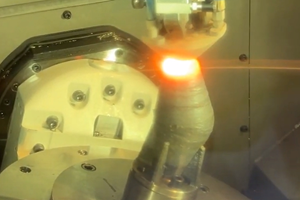Split Personality
At the Canadian Machine Tool Show in late 2001, this company introduced its new H/V machining center. H/V stands for horizontal/vertical. OK, so it's a universal machining center ... big deal.
Share






At the Canadian Machine Tool Show last fall, HH Roberts Machinery (Mississauga, Ontario, Canada) introduced its new H/V machining center. H/V stands for horizontal/vertical. OK, it's a universal machining center: big deal.
Well, true it can technically be called a universal machining center because it can cut from either a horizontal or vertical spindle orientation. It does, however, approach its "universalness" from a different direction. The direction is different enough to qualify for a U.S. patent.
Essentially the difference in HH Roberts' machining center design is it carries independent vertical and horizontal spindles (each rated at 15 horsepower) on a common set of ways, mounted to a single column. The design allows both spindles to cover a generous work envelope and, with a rotary indexer mounted on the worktable, provide five-sided machining capability in a single setup.
With both spindles on the machine centerline, the full X-axis travel is available to each. This is key to work zone coverage. Travel on the show machine is 43 by 22 inches for its X and Y axes. The vertical head travel is 32 inches, as is the horizontal head. The design is scalable with 50- and 60-inch X-axis travel models due to be introduced soon.
The H/V is designed for job shops. Virtually every metalworking business is trying to get cost out of its process. Job shops are no exception. Five-sided machining in a single handling is one quick method to increase throughput by eliminating work-in-process.
In operation, the machine is only slightly different from a conventional vertical machining center. Programming conventions universally accept that the Z axis is parallel to the axis of spindle rotation. So for programming purposes, going from one spindle to the other changes the designation of the Y and Z axes.
The horizontal spindle is programmed in the same manner as a vertical machining center. On this machine, the Z-axis feed is accomplished by moving the worktable toward the column. A 6-inch positioning quill on the horizontal spindle allows use of optimum length tooling to access the side of a workpiece.
The machine uses an Anilam 5400 or 5500 CNC, depending if the machine is equipped for full five-axis or four-axis machining. Anilam wrote custom software for this unique machine configuration that automatically swaps the axis coordinates when switching from vertical to horizontal spindle. When this happens, tool offsets are automatically applied to the horizontal spindle. A mobile console-mounted CNC is available for the H/V that can be positioned in front of the machine for vertical processing and behind the machine for horizontal machining, which is generally preferred.
A 20-tool capacity automatic tool changer is available for the vertical spindle and was shown on the show machine. In its simplest form, the horizontal spindle is hand loaded from an access door behind the worktable. For more tool capacity, several tool changer configurations, up to 60 tools total, are available. The larger unit is designed to supply both spindles from its magazine.
Having the option to cut workpieces with either the horizontal or vertical spindle or both extends the processing capability of the job shop. While the company admits the machine is not designed to replace high tolerance horizontal machining centers, it will produce parts to general commercial tolerances of just under a thousandth of an inch at an economical price.
Related Content
Lean Approach to Automated Machine Tending Delivers Quicker Paths to Success
Almost any shop can automate at least some of its production, even in low-volume, high-mix applications. The key to getting started is finding the simplest solutions that fit your requirements. It helps to work with an automation partner that understands your needs.
Read MoreAdditive/Subtractive Hybrid CNC Machine Tools Continue to Make Gains (Includes Video)
The hybrid machine tool is an idea that continues to advance. Two important developments of recent years expand the possibilities for this platform.
Read MoreOrthopedic Event Discusses Manufacturing Strategies
At the seminar, representatives from multiple companies discussed strategies for making orthopedic devices accurately and efficiently.
Read MoreWhich Approach to Automation Fits Your CNC Machine Tool?
Choosing the right automation to pair with a CNC machine tool cell means weighing various factors, as this fabrication business has learned well.
Read MoreRead Next
Machine Shop MBA
Making Chips and 91ÊÓƵÍøÕ¾ÎÛ are teaming up for a new podcast series called Machine Shop MBA—designed to help manufacturers measure their success against the industry’s best. Through the lens of the Top Shops benchmarking program, the series explores the KPIs that set high-performing shops apart, from machine utilization and first-pass yield to employee engagement and revenue per employee.
Read MoreAMRs Are Moving Into Manufacturing: 4 Considerations for Implementation
AMRs can provide a flexible, easy-to-use automation platform so long as manufacturers choose a suitable task and prepare their facilities.
Read MoreLast Chance! 2025 Top Shops Benchmarking Survey Still Open Through April 30
Don’t miss out! 91ÊÓƵÍøÕ¾ÎÛ's Top Shops Benchmarking Survey is still open — but not for long. This is your last chance to a receive free, customized benchmarking report that includes actionable feedback across several shopfloor and business metrics.
Read More





















